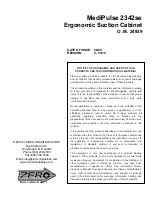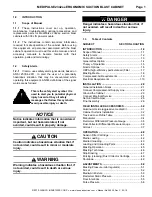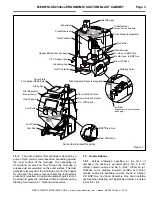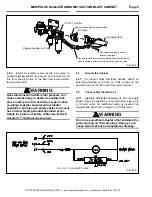
MEDIPULSE 2342se ERGONOMIC SUCTION BLAST CABINET
Page 5
© 2019
CLEMCO INDUSTRIES CORP.
www.clemcoindustries.com
Manual No. 24939, Rev. C, 03/19
1.9
Compressed-Air Requirements
1.9.1
The size of the compressor required to operate
the cabinet depends on the size of the air jet and
blasting pressure. Unless otherwise specified, cabinets
are supplied with a No. 5 (5/32" orifice) jet. Refer to the
table in Figure 2 to determine air consumption. Consult
with a compressor supplier for a suggested compressor
size based on the air consumption.
Compressed-Air Consumption in CFM
BNP Gun
Jet
Orifice
Nozzle
Orifice
CFM
PSI
No. 4
1/8"
5/16"
21
80
No. 5
5/32"
5/16"
33
80
*No. 6
3/16"
3/8"
48
80
* Using a No.6 jet and nozzle in applications that
produce excessive dust may cause poor visibility.
The 300 cfm reclaimer may not recover heavy,
coarse abrasive from the cabinet hopper when
using a No. 6 jet and nozzle combination.
Figure 2
1.9.2
The air filter at the air-inlet connection, removes
condensed water from the compressed air. Its use is
especially important in areas of high humidity or when
using fine-mesh media. Moisture causes media to clump
and inhibits free flow through the feed assembly. If the
filter does not remove enough moisture to keep media
dry and flowing, it may be necessary to install an air
dryer or aftercooler in the air-supply line.
1.10
Electrical Requirements
1.10.1
Electrical requirements depend on the size and
phase of the motor. Standard cabinets are supplied with
300 cfm reclaimer, using 1/2 HP, 115/230V, 1 PH, 60 HZ
motors, wired for 115 volts. FLA 20/7, 208/3.4, 240/3.5.
1.10.2
A power cord with u-ground plug is provided.
2.0
INSTALLATION
2.1
General Installation Notes
2.1.1
Select a location where compressed air and
electrical service are available. The cabinet location
must comply with OSHA and local safety codes. Allow
for full access to all doors and service areas and for
efficient handling of large parts.
2.2
Connect Compressed-Air Supply Line
WARNING
Failure to observe the following before
connecting the equipment to the compressed-
air source can cause serious injury from the
sudden release of trapped compressed air:
Lockout and tagout the compressed-air
supply.
Bleed the compressed-air supply line.
WARNING
To avoid the risk of injury from compressed air,
install an isolation valve and bleed-off valve
where the air supply is tapped into the
compressed-air system. This enables a lockout
and tagout procedure and depressurization of
the compressed-air line before performing
maintenance.
2.2.1
Refer to Paragraph 2.2.2 to determine the
recommended air-supply hose size, then refer to Figure
4 and apply thread sealant to the male threads of an air
fitting that is compatible with the air-supply hose fitting,
and install it onto the 1/2-NPT air filter located within the
power module. The style of connection shown in Figure
4 is for reference only.
2.2.2
Refer to the table in Figure 3 to determine the
minimum ID of air-supply line to the cabinet. A smaller
diameter hose may reduce blasting efficiency.
MINIMUM ID COMPRESSED-AIR LINE
Jet Size
Air Line Length
1/8"
No. 4
5/32"
No. 5
3/16"
No. 6
25 feet
3/4"
3/4"
1"
50 feet
3/4"
3/4"
1"
75 feet
3/4"
1"
1"
100 feet
3/4"
1"
1"
Figure 3







































